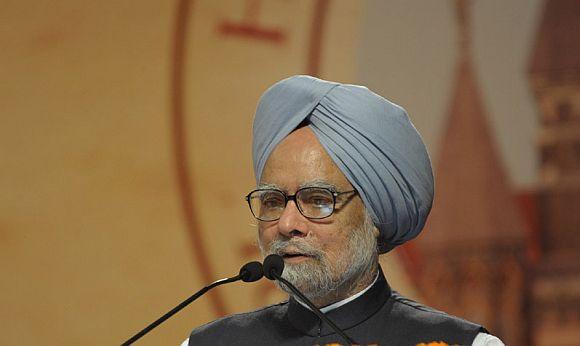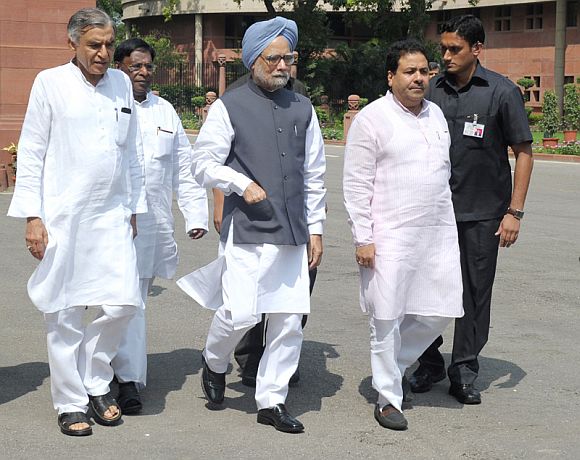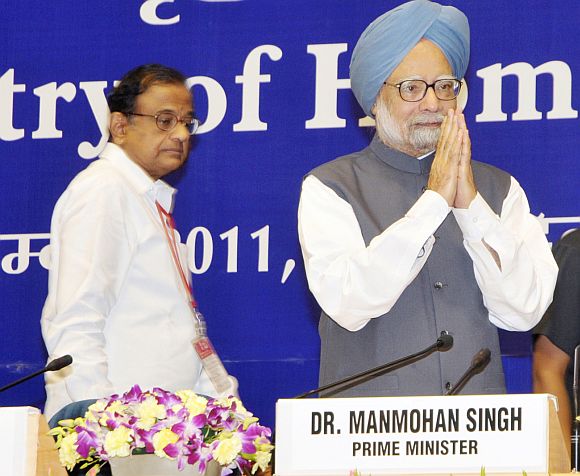 | « Back to article | Print this article |
PM: Poverty declined, economy grew, BUT...
Prime Minister Manmohan Singh on Saturday sought to highlight his government's accomplishments at the meeting of the Planning Commission in New Delhi.
Here are the highlights of the Prime Minister's speech:
We ended the Eleventh Plan with some notable achievements. The economy grew at an average annual rate of 7.9 per cent. This is commendable for a period which saw two global crises -- one in 2008 and another in 2011.
Poverty declined twice as fast between 2004-05 and 2009-10 than it did in the previous ten years.
Agriculture grew at 3.3 per cent per year in the Eleventh Plan, much faster than the 2.4 percent observed in the Tenth Plan.
However, we must also recognise that the Twelfth Plan is starting in a year when the world economy is experiencing difficulties and our economy has also slowed down. These short term problems present a challenge, but they should not lead to undue pessimism about our medium term prospects.
Click on NEXT to read further...
'Our objective is not just growth of GDP, but growth that is inclusive'
The economy has gained many strengths. Our immediate priority must be to orchestrate a rebound in the second half of the current year. We should then try to accelerate growth to reach around 9 percent by the end of the Plan period. This will yield a target growth rate of around 8.2 per cent over the Twelfth Plan. This is lower than the 9 per cent originally projected, but some downward revision is realistic given the state of the world.
As the Plan document points out, our objective is not just growth of GDP, but growth that is inclusive and also sustainable. The SC/STs, OBCs, and the minorities must all participate fully in the growth process. The Plan has many elements designed to ensure this.
The most important area for immediate action is to speed up the pace of implementation of infrastructure projects. This is critical for removing supply bottlenecks which constrain growth in other sectors. It will also boost investor sentiment to raise the overall rate of investment.
The infrastructure ministries must set ambitious goals for their sectors over the Twelfth Plan. We need close to a trillion dollars of investment in infrastructure and we have to work hard to achieve this. I will personally review the performance of the infrastructure ministries compared with targets at the end of the first six months. I hope that out of this review we can define an agenda for improved implementation.
Click on NEXT to read further...
'Programmes must deliver results on the ground'
Turning to the longer term policy agenda, the Plan can be seen as consisting of three broad components.
One is the set of Government programmes aimed at achieving specific sectoral objectives. The Plan contains ambitious programmes in health, education, water resource management, infrastructure development, and a number of programmes aimed at inclusiveness, most notably the MGNREGA, the PMGSY, the IWDP and the National Rural Livelihoods Mission.
Considerable resources are being allocated for these programmes. We need to pay much greater attention to making sure that these programmes are also delivering results on the ground, especially for the SCs/STs and the weaker sections. Some of the changes in the Centrally Sponsored Schemes suggested by the Chaturvedi Committee will help to improve effectiveness.
The second component relates to macro economic balance. To achieve the target of 8.2 percent growth we need to revive investment in the economy. The investment environment is therefore critical. Our fiscal deficit is too high and is attracting adverse comment from analysts. It must be brought down over the medium term to release domestic resources for productive deployment in the economy.
Because export prospects are weak, the Plan projects a current account deficit of 2.9 per cent of GDP. This must be financed mainly through FDI and FII flows, so that reliance on external debt is limited. I believe we can attract the financing we need provided our fiscal deficit is seen to be coming under control and the growth momentum is regained.
Click on NEXT to read further...
A few key sector priorities
The third key component of the Plan is the set of policies which can improve performance in individual sectors. Let me mention a few key sector priorities.
1) Health, education, and skill development are key sectors which enhance human capability and can contribute hugely to the objective of inclusive growth. They have been given high priority in the Twelfth Plan.
2) Agricultural growth must be accelerated to about 4 percent.
3) Manufacturing must grow much faster than it has, to generate the employment growth we need.
4) Infrastructure development is vital. It needs a combination of public investment and PPP.
5) Energy is a difficult area where our policy needs a comprehensive review. We are energy deficient and import dependence is increasing. It is vital for our energy security that we increase domestic production and also increase energy efficiency. Rational energy pricing is therefore critical. Our energy prices are out of line with world prices. The recent increase in diesel prices is an important step in the right direction.
6) Water is another area where problems of scarcity and the challenges of effective resource management are likely to expand in the years ahead.
7) Urbanisation is a new challenge which we must address.
Click on NEXT to read further...
Three alternative scenarios
The Plan for the first time introduces alternative scenarios.
Scenario one is called "Strong Inclusive growth". It presents what is possible if the policy actions outlined in the Plan are substantially implemented. One can expect a number of virtuous cycles to start operating, leading to positive results on both growth and inclusion. This is the scenario we should aim for.
Scenario two is called "insufficient action:. It describes a state of partial action with weak implementation. The virtuous cycles that reinforce growth in Scenario I, will not kick in, and growth can easily slow down to 6 to 6.5 percent. Inclusiveness will also suffer. This is where we will end up if we make only half-hearted efforts and slip in implementation. It is my sincere hope that we do not do so.
Scenario three is called "policy logjam". It reflects a situation where for one reason or another, most of the policies needed to achieve Scenario 1 are not taken. If this continues for any length of time, vicious cycles begin to set in and growth could easily collapse to about 5 percent per year, with very poor outcomes on inclusion. I urge everyone interested in the country's future to understand fully the implications of this scenario. They will quickly come to an agreement that the people of India deserve better than this.




